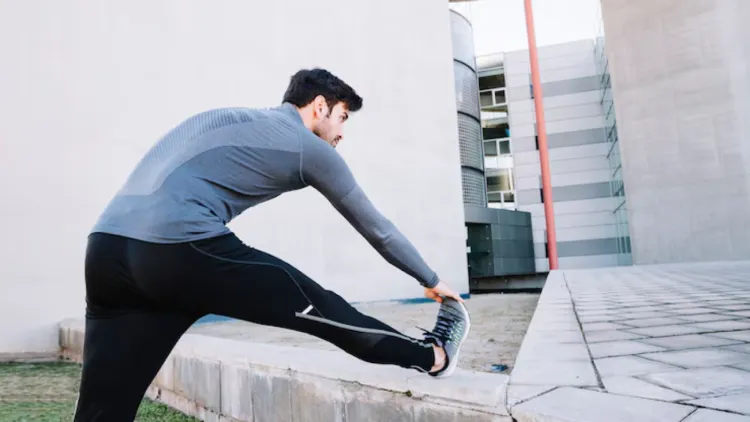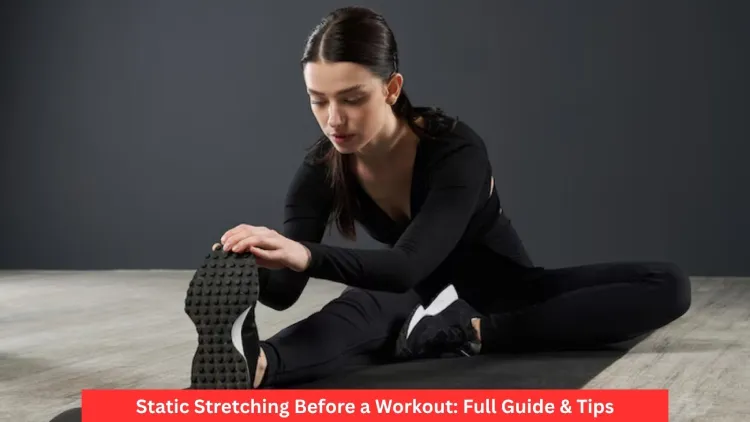A common method of flexibility, muscle loosening, and psychological warming-up of the body to exercise is Static stretching before a workout. It consists of stretching muscles to a lengthy position, improving the range of movement and relaxing the nervous system.
Although it is a training method that can bring positive effects, such as posture, muscle tightness, and injury prevention to some people, recent studies indicate that it is not the best training option when it comes to increasing strength and improving performance during high-intensity training. This post discusses the uses of static stretching when it is effective, the comparison with dynamic stretching, and the most suitable method of incorporating it into your lifestyle fitness program.

What Is Static Stretching?
Static stretching is the act of stretching a certain muscle or group of muscles to the furthest position and sustaining the stretch within a range of time, normally 15 to 60 seconds. In comparison to dynamic movements, static stretches are conducted in one position, and this assists in elongating muscles and increasing the overall flexibility in the long run. Static stretching has been a part of warm-up routines for a long time now; however, recent research has caused a reconsideration of the place of static stretching in exercise preparation.
Common Types of Static Stretches:
- Hamstring stretch
- Calf stretch
- Quadriceps stretch
- Shoulder stretch
- Triceps stretch
These are the types of stretches normally seen in flexibility programs and post-exercise cooldowns, though some individuals still perform static stretching as a part of a warm-up despite more recent recommendations.
Is Static Stretching Before a Workout Effective?
Static stretching before a workout is not necessarily bad, but it again depends on the activity you are about to do. A number of studies have indicated that static stretching prior to high-intensity or explosive cycles can have a minor yet negative impact on muscle power and performance. Nonetheless, it can still be advantageous in some low-level or rehabilitative situations.
Pros of Static Stretching Before a Workout:
- Increases range of motion and muscle length: By maintaining the muscles in a stretched position, the joint flexibility may be gradually improved, which is beneficial to avoid injury.
- Aids in muscle stiffness in a tight spot: If you have tight hamstrings, hip flexors, or shoulders, then static stretching can help loosen the tightness and improve the range of motion before a light activity.
- Offers a relaxing, concentrated beginning to exercise: Static stretches may offer psychological relaxation and concentration prior to the start of a training session.
- Can be useful before low-impact exercising: Static stretching can be used as a part of a warm-up in activities such as yoga, Pilates, or stretch-based classes without any adverse consequences.
Cons of Static Stretching Before a Workout:
- Temporarily decreases power and strength in muscle: Despite the fact that this has been refuted in the past, studies have now demonstrated that static stretching before strength training or sprinting can temporarily reduce force output.
- Can reduce speed and agility performance: Static stretching as a warm-up might reduce the performance of athletes in sports that involve quick bursts of energy.
- Failing to properly prepare the body to move dynamically: Static stretching does not increase heart rate or activate muscles dynamically like dynamic stretching does because it is non-movement-based.

Why Dynamic Stretching Is Better Before a Workout
Dynamic stretching has currently been viewed as a better form of warming up before the majority of workouts. This is an active stretching, which means that the movements resemble those of your intended exercise. It warms up muscles, joints, and the nervous system, preparing them for heavier activities.
Examples of Dynamic Warm-Up Exercises:
- Arm circles and shoulder rolls: Improve upper body mobility and prepare shoulders for movement.
- Leg swings and walking lunges: Activate hip flexors, hamstrings, and quadriceps.
- Jumping jacks and high knees: Raise heart rate and improve cardiovascular readiness.
- Hip openers and butt kicks: Improve range of motion and activate glutes.
Benefits of Dynamic Stretching Before a Workout:
- Enhances the blood flow to muscles
- Increases the activation of muscles and lubrication of joints
- Enhances neuromuscular coordination and reaction time
- Reduces the chances of strains and muscle pulls in the course of training
Dynamic stretching is particularly useful before resistance training, running, high-intensity interval training (HIIT) or agility- and speed-demanding sports. It warms up the body, Mary, in a plane that static stretching before a workout does not.
When to Use Static Stretching
Although there are drawbacks to static stretching before a workout, that does not mean that it is not an important component of a well-balanced fitness program; it just needs to be done at the appropriate time. Static stretching should be done after your workout in the cool-down period.
Benefits of Post-Workout Static Stretching:
- Enhances muscle elasticity: Stretching of warm muscles enhances the capacity of the muscles to return to their resting length and function.
- Prevent injuries and muscle recovery: Helps to avoid post-workout muscle tightness, which causes imbalances.
- Alleviates exercise-induced soreness: Promotes the elimination of metabolic waste and circulation.
- Encourages rest and stress release: Decelerates breathing and allows the body to go back to a relaxed mode.
Best Practices for Static Stretching
In case you still decide to do static stretching before a workout, particularly in low-impact programs, observe the following best practices to limit the performance losses:
- Stretch out slowly: All stretching should be preceded by 5 to 10 minutes of light cardiovascular activity, like brisk walking or cycling, to get the blood flowing and warm the muscles.
- Stretch problem areas or tight muscles only: Static stretches should be used to reduce the tension in areas that might restrict performance or which are painful.
- No need to go hard: When using it as a pre-workout, keep each stretch to 20 to 30 seconds. Do not stretch or bounce.
- Dynamic stretching: Static stretching should be accompanied by dynamic exercises to complete the action of warming up the body.
- Learn to listen to your body: In case you find one muscle weaker following stretching, either lighten up or change the stretch to the post-workout.
Static vs. Dynamic Stretching: A Summary
| Feature | Static Stretching Before a Workout | Dynamic Stretching Before a Workout |
| Muscle Activation | Low | High |
| Improves Flexibility | Yes (especially post-workout) | Moderate |
| Prepares for Movement | Not effectively | Highly effective |
| Risk of Performance Drop | Possible with power/speed exercises | Unlikely |
| Best Timing | After a workout or for light activities | Before workout |
Special Considerations
It is not that static stretching before a workout is never helpful: there are still some populations and situations where it can be useful.
- Older adults: Older adults who have stiffness or difficulty moving their joints could perform light static stretching prior to low-intensity activity.
- Rehabilitation: Static stretching may be employed by individuals recuperating from pulsed physical therapy stretching injuries under the guidance of a physical therapist.
- Mind-body classes: In yoga or tai chi, static stretching may be included in warm-ups with no negative influence on performance.
In such instances, Static stretching could provide some psychological and physical advantages when implemented with care and awareness.

Final Thoughts
Although static stretching before a workout is not bad, it should not form the bulk of your warm-up, particularly in high-performance or explosive sports. Rather, focus on dynamic exercises to wake up your muscles, increase your heart rate, and warm up your joints to the upcoming tasks.
Apply static stretching as a strategic post-workout to enhance flexibility, decrease soreness, and aid muscles in recovering. By balancing out the static and dynamic methods, you will decrease your chance of injury, improve performance, and create a well-balanced fitness routine that will help support your long-term objectives.
The knowledge of when and how to stretch is as important as the stretches themselves, and such information can be the key to your successful training.
Frequently Asked Questions
Does static stretching before exercise help?
It may assist with preparing stiff muscles and relaxing the brain, yet it is not the best option before intense physical activities. It can cause momentary loss of strength and speed.
What is the use of static stretching?
It is most effective after exercises or ahead of low-impact exercises such as yoga or rehab treatments to enhance stretchiness and ease muscle knots.
Is it possible to combine static and dynamic stretches?
Yes, but begin with dynamic moves. Apply static stretching to sore spots only, and never stretch cold.
When is the most appropriate time to do static stretching?
The best time to acquire flexibility and assist in recovery is after your exercise, when the muscles are warm.







